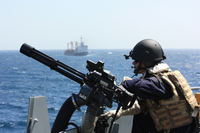A multinational flotilla of warships has been assembled off the coast of Somalia to do what warships have done for as long as navies have existed: fight pirates. However, the combined efforts of France, Britain, Russia, China, India, the United States, and others have not sufficed to prevent the pirates from targeting ships across the breadth of the Indian Ocean. In much the same way that poorly equipped insurgents are resisting U.S. military efforts in Afghanistan, impoverished Somalis continue to frustrate the great naval powers. Indeed, counterpiracy and counterinsurgency share a common frailty: Both lack good metrics for evaluating success, which threatens not only tactical effectiveness, but also the ability to assess sound grand strategic policy.
Last month, the Government Accountability Office released a report on U.S. anti-piracy efforts detailing U.S. progress along 14 tasks associated with piracy prevention off the Horn of Africa. The report determined that the United States had made substantial progress on four of these tasks, some progress on eight more, and no progress on one. (The remaining task, the establishment of a regional coordination center, has been abandoned as redundant.) Overall, the report was somewhat skeptical of the effectiveness of U.S. anti-piracy efforts, noting that while pirate attacks in certain areas had dropped, ransoms had increased and pirates had begun to operate further from Somali shores. The report also criticized the lack of metrics to measure the effectiveness of anti-piracy efforts, which makes it difficult to assess progress.
The GAO identified some clear weak spots in U.S. anti-piracy efforts. For one, authorities have been more adept at developing cooperative relationships with foreign navies than in facilitating interagency cooperation among U.S. stakeholders. For example, tracking the flow of illicit money is a key element of any effort to combat organized crime, and has taken an increasingly large role in anti-terrorism strategies. However, tracking money moving through pirate hands in Somalia remains the responsibility of several different U.S. agencies, none of which have coordinative responsibility. For another, U.S. efforts to influence events on dry land in Somalia remain virtually non-existent. For entirely sensible political reasons, the United States and coalition partners have resisted direct intervention within Somalia. But this reluctance means that Somali pirates continue to operate from safe havens, with increasingly sophisticated support infrastructure.

